SSZT431 August 2019 DLP3030-Q1 , DLP3034-Q1 , DLP5530-Q1 , DLP5534-Q1
In the future, your vehicle’s windows may display all kinds of information. New automotive technologies promise to turn standard automotive windows into single-color or even full-color dynamic displays. The two primary applications behind this trend are vehicle-to-pedestrian communication and advertising, illustrated respectively in Figure 1 and Figure 2.
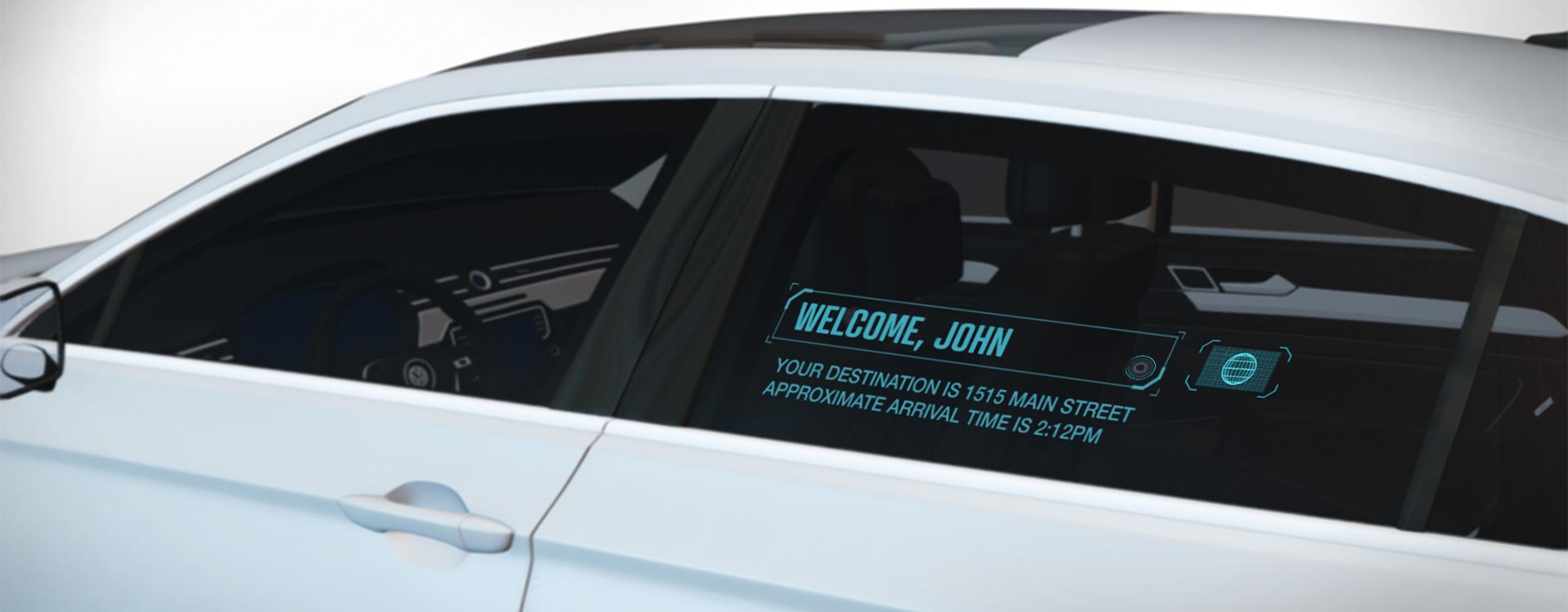 Figure 1 Ride-hailing Transparent
Display Example
Figure 1 Ride-hailing Transparent
Display Example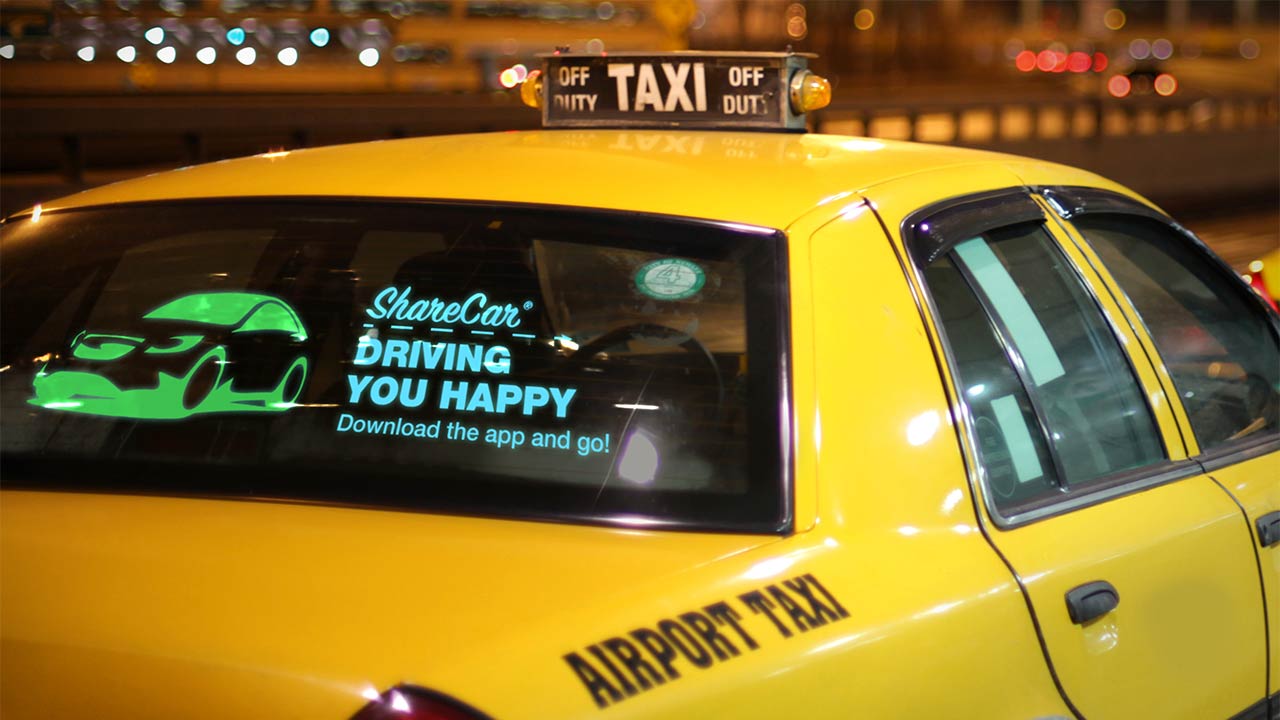 Figure 2 Advertising Transparent
Display Example
Figure 2 Advertising Transparent
Display ExampleLet’s first spend a little time on the basics. A transparent window display needs to support two display states: a fully transparent one and a dynamic colorful one. When not displaying information, the window must be transparent, and ideally look identical to the other windows in the car. When communicating information or playing a video, the window needs to display bright, colorful graphics that pedestrians can easily see.
A projector-based transparent window display consists of a small projector mounted to the interior roof surface or other location, and a transparent film typically sandwiched or laminated in the vehicle’s side or rear windows, or even the front windshield. There are several types of films:
- 405-nm emissive phosphor: This type of film contains a phosphor layer excited by a 405-nm light source. The energy from the 405-nm light source excites the phosphor, which then re-emits the energy at a different wavelength such as blue or green. The light is emitted in all directions, so the image is visible from any viewing angle. It is possible to create multicolor displays by using multiple films, each emitting a different color and excited by different wavelengths in the low 400-nm range. A 405-nm-compatible projector is required to illuminate this type of film.
- Smart glass: A smart glass film has two states: transparent and “frosted.” State transitions occur when applying or removing a voltage from the glass, similar to the types of films used in e-tinting applications. The image is projected onto the inside of the glass when in the frosted state, similar to how a rear-projection TV works. The frosting provides good contrast, improving the image quality. A red-green-blue (RGB) LED projector can illuminate this film.
- Microlens array diffuser: This is an engineered diffuser film that can provide some amount of screen gain, increasing the brightness of an image. Screen gain is a result of diffusing or concentrating the light directionally. For example, instead of transmitting the light in all directions, the film is engineered to define a viewing angle where the image is visible. Outside the viewing angle, there is no visible image, as all of the light is concentrated inside the defined viewing angle. An RGB LED projector can illuminate this film.
- Holographic film: These films promise some very unique features, such as the ability to create an image viewable from inside the car but not from the outside. An RGB projector can illuminate this film. Achieving maximum efficiency and brightness requires careful selection of the LED wavelengths in order to match the holographic film, and the use of a true green LED (versus a converted green LED) at the appropriate wavelength.
All of these films have their strengths and weakness. Depending on the application, one type of film may be better suited than the others. One of the advantages of TI DLP® technology is that it is light source-agnostic and can illuminate all of the various film types. Figure 3 illustrates how a projector is placed in a car to create transparent window displays.
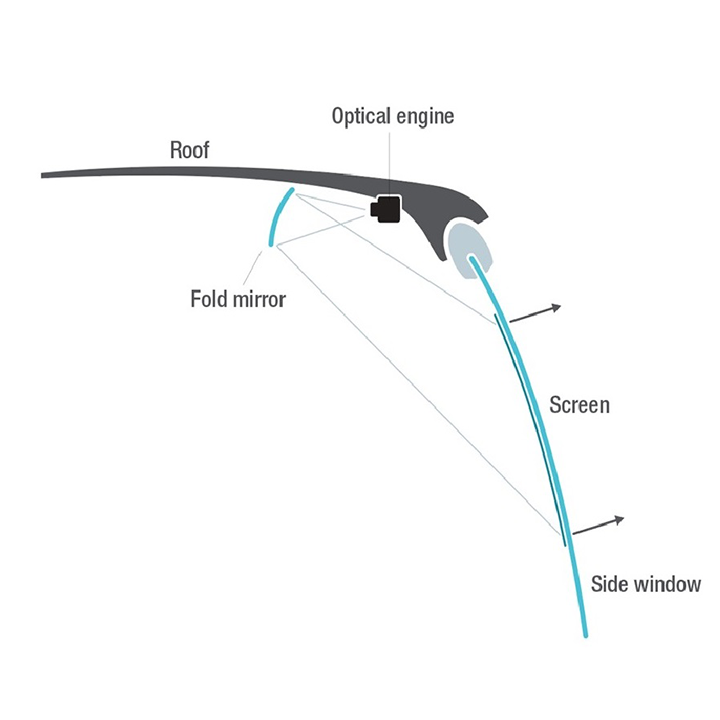 Figure 3 DLP Projector Placement
Options
Figure 3 DLP Projector Placement
Options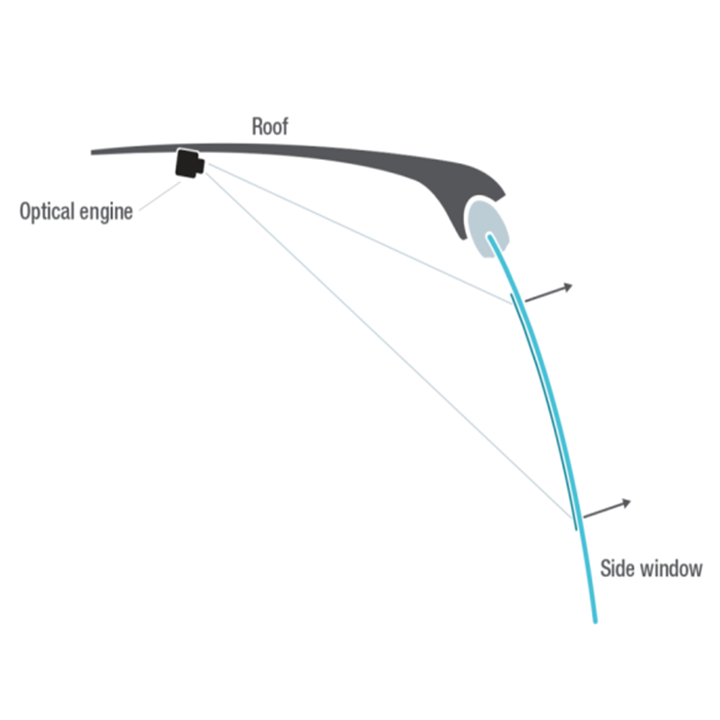
It turns out that brightness is one of the key challenges in transparent display designs. Displaying an image at night is fairly straightforward, but displaying that same image during the day can be a significant challenge. The display has to be bright enough to be visible in full daylight. In addition, the display size is directly proportional to the amount of light needed; for example, if you double the display size area and want to keep brightness levels the same, you will need to double the projector’s optical output power. Other design considerations include projector size and placement, film qualification and lamination, and regional automotive window regulations.
Okay, back to the applications. A great example application of a transparent window display is a ride-hailing service like Uber, Lyft, DiDi or Grab. With a transparent window display, passengers can easily identify their taxi through a display on the side window with their name and destination, or perhaps a verification code corresponding to a code on the ride-hailing app.
Autonomous ride-hailing is an even better application fit than traditional ride-hailing. An autonomous car obviously has no driver; therefore, the car needs a way to communicate to other cars and pedestrians. Figure 4 shows various applications for autonomous vehicle communication. For example, how does an autonomous car communicate that it “sees” a pedestrian and that it is OK to cross in front of the car? Which car goes first at a four-way stop? There are many situations in which the vehicle needs to signal intent to pedestrians or other vehicles. A transparent display is a good fit, since it’s placed high up on a vehicle and is easily visible to those around it.
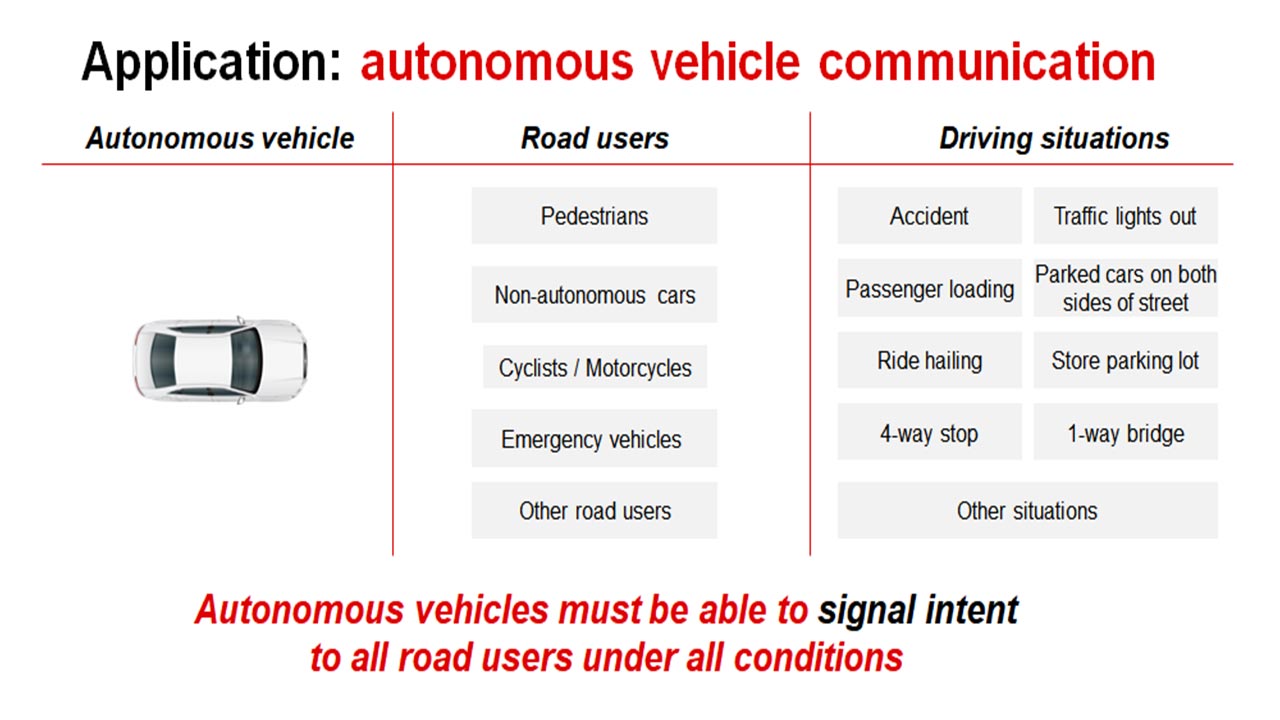 Figure 4 Autonomous Vehicle
Communication Requirements
Figure 4 Autonomous Vehicle
Communication RequirementsAdvertising is the other primary target application. The ability to generate incremental monthly revenue for ride-hailing services via geotargeted advertising campaigns is attracting a lot of interest because it could increase the profitability of the service (as much as US $300 per month of incremental revenue) and/or driver wages.
An example of a geotargeted advertising campaign would be running an ad for Starbucks every time the vehicle is within 100 m of a Starbucks location. Other potential applications include in-car entertainment, as shown in Figure 5 driver greetings, car diagnostics and car entry touch screens.
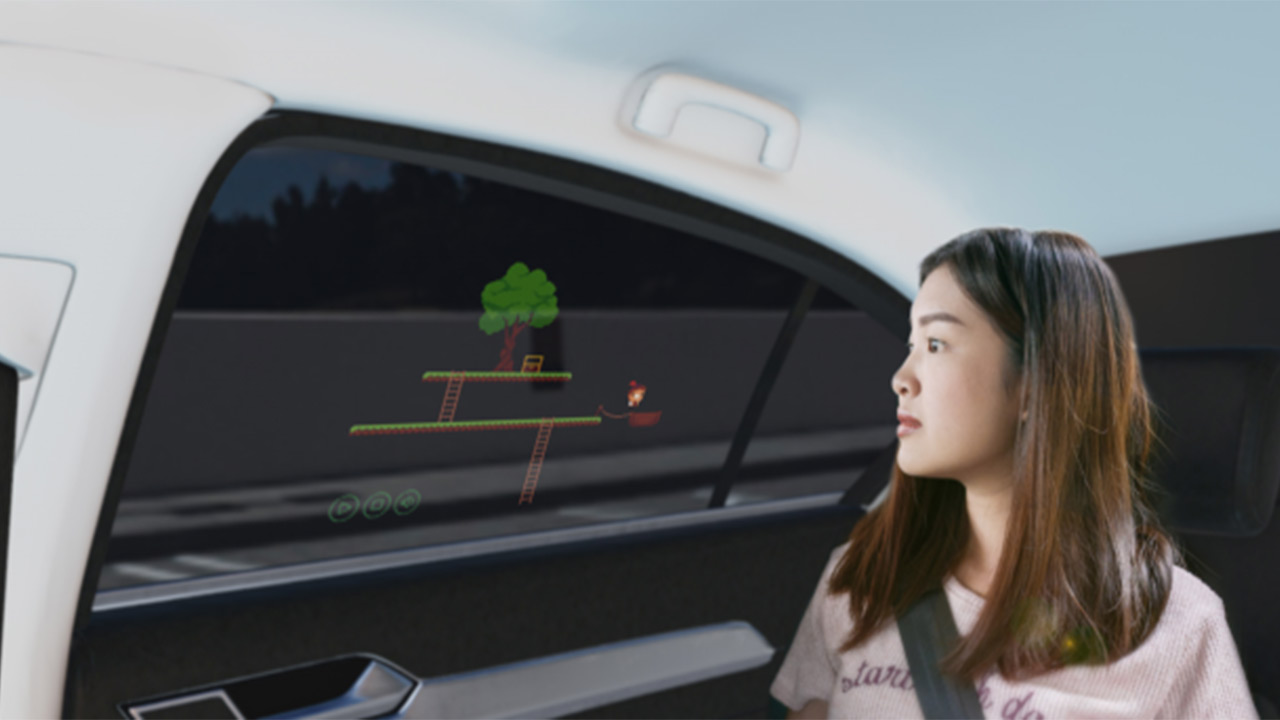 Figure 5 In-car Entertainment
Transparent Display Example
Figure 5 In-car Entertainment
Transparent Display ExampleAdditional Resources
- Download the DLP3030-Q1 RGB projector electronics reference design.
- Get the Automotive SPD-SmartGlass™ driver reference design.
- Learn more about the transparent window display application.